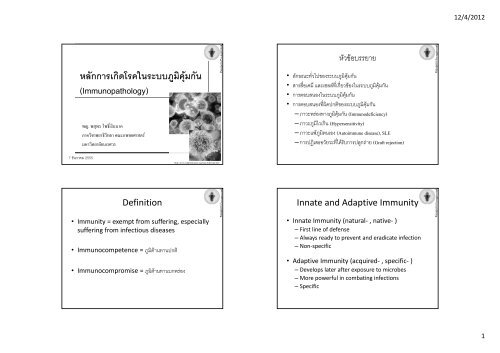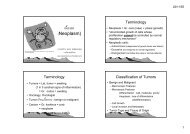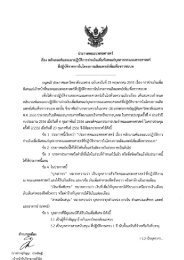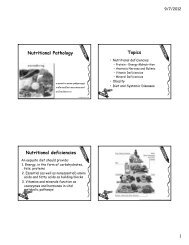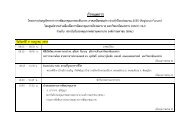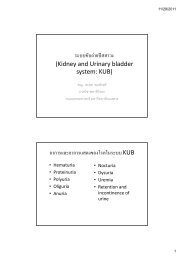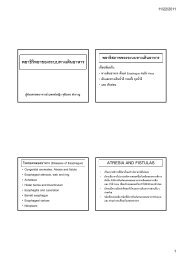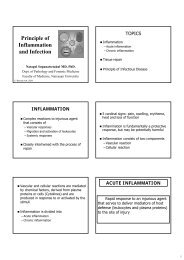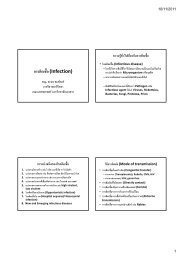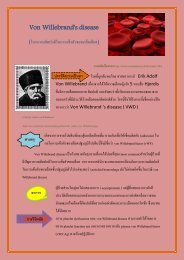Hand out sheet - Faculty of Medicine - มหาวิทยาลัยนเรศวร
Hand out sheet - Faculty of Medicine - มหาวิทยาลัยนเรศวร
Hand out sheet - Faculty of Medicine - มหาวิทยาลัยนเรศวร
- No tags were found...
You also want an ePaper? Increase the reach of your titles
YUMPU automatically turns print PDFs into web optimized ePapers that Google loves.
12/4/2012หลักการเกิดโรคในระบบภูมิคุมกัน(Immunopathology)พญ. พสุพร โพธิ์เงินนาคภาควิชาพยาธิวิทยา คณะแพทยศาสตร<strong>มหาวิทยาลัยนเรศวร</strong>Pasuporn Po-ngernnakหัวขอบรรยาย• ลักษณะทั่วไปของระบบภูมิคุมกัน• สารสื่อเคมี และเซลลที่เกี่ยวของในระบบภูมิคุมกัน• การตอบสนองในระบบภูมิคุมกัน• การตอบสนองที่ผิดปกติของระบบภูมิคุมกัน– ภาวะพรองทางภูมิคุมกัน (Immunodeficiency)– ภาวะภูมิไวเกิน (Hypersensitivity)– ภาวะแพภูมิตนเอง (Autoimmune disease), SLE– การปฏิเสธอวัยวะที่ไดรับการปลูกถาย (Graft rejection)Pasuporn Po‐ngernnak7 ธันวาคม 2555http://www.lymphomation.org/type-follicular.htmDefinition• Immunity = exempt from suffering, especiallysuffering from infectious diseases• Immunocompetence = ภูมิตานทานปกติ• Immunocompromise = ภูมิตานทานบกพรองPasuporn Po‐ngernnakInnate and Adaptive Immunity• Innate Immunity (natural‐ , native‐ )– First line <strong>of</strong> defense– Always ready to prevent and eradicate infection– Non‐specific• Adaptive Immunity (acquired‐ , specific‐ )– Develops later after exposure to microbes– More powerful in combating infections– SpecificPasuporn Po‐ngernnak1
12/4/2012Pasuporn Po‐ngernnakInnate Immunity• Epithelial barriers : block entry <strong>of</strong> microbesPasuporn Po‐ngernnak• Phagocytes: Neutrophil, Macrophage– Microbes are internalized and destroyed by reactive oxygen, hydrolyticenzymes, resulting in inflammation.• Dendritic cells, natural killer (NK) cells : anti‐viral defense• Complement proteins: most important plasma proteins <strong>of</strong> the innateimmunity• Lung surfactant, respiratory epithelium, mucus, cilia, cough reflexThe principal mechanisms <strong>of</strong> innate immunity and adaptive immunity. NK, natural killer.• Hydrochloric acid (HCl), GI epitheliumDownloaded from: Robbins Basic Pathology 9E (on 26 November 2012) © 2012 ElsevierAdaptive Immunity• Mainly consists <strong>of</strong> lymphocytes and theirproducts, including antibodiesPasuporn Po‐ngernnak• Cell‐mediated (cellular) immunity (T cell)– Defense against intracellular microbes• Humoral immunity (Antibody)– Defense against extracellular microbes and theirtoxinsDownloaded from: Robbins & Cotran Pathologic Basis <strong>of</strong> Disease (on 2 June 2009 11:29 AM)© 2007 Elsevier2
12/4/2012หัวขอบรรยาย• ลักษณะทั่วไปของระบบภูมิคุมกัน• สารสื่อเคมี และเซลลที่เกี่ยวของในระบบภูมิคุมกัน• การตอบสนองในระบบภูมิคุมกัน• การตอบสนองที่ผิดปกติของระบบภูมิคุมกัน– ภาวะพรองทางภูมิคุมกัน (Immunodeficiency)– ภาวะภูมิไวเกิน (Hypersensitivity)– ภาวะแพภูมิตนเอง (Autoimmune disease), SLE– การปฏิเสธอวัยวะที่ไดรับการปลูกถาย (Graft rejection)Pasuporn Po‐ngernnakCells and Tissues <strong>of</strong> the ImmuneSystemLymphoid TissuesLymphocyte•B Lymphocytes•T Lymphocytes•Natural Killer CellsAntigen – PresentingCells• Dendritic Cells• MacrophagePasuporn Po‐ngernnakLymphocytesPasuporn Po‐ngernnakB LymphocytesPasuporn Po‐ngernnakhttp://www.emc.maricopa.edu/faculty/farabee/biobk/biobookglosspq.htmColoured scanning electron micrograph (SEM)<strong>of</strong> B lymphocytePlasma cellDownloaded from: Robbins & Cotran Pathologic Basis <strong>of</strong> Disease 8 th (on 26 Nov 2012) Copyright © 2012 Elsevier IncThe principal classes <strong>of</strong> lymphocytes and their functions in adaptive immunityhttp://www.jbc.org/content/276/23.cover‐expansionhttp://home.kku.ac.th/acamed/kanchana/bsi.html3
12/4/2012B Lymphocytes• Bone marrow – derived, or “B” cells• 10‐20% in circulating blood, bone marrow, lymph nodes,spleen, tonsils, GI tract• After stimulation, B cells form “plasma cells” thatsecrete immunoglobulins (antibody)Pasuporn Po‐ngernnakPasuporn Po‐ngernnak• 5 basic Immunoglobulins isotypes: IgG, IgM, IgA, IgE, IgDDownloaded from: Robbins Basic Pathology 9E (on 26 November 2012) © 2012 Elsevier• Recognize antigen via monomeric surface IgM, “B‐cellreceptor (BCR)”B cell receptor complex is composed <strong>of</strong> membrane IgM and the associatedsignaling proteins Igα and Igβ.CD21 is a receptor for a complement component that promotes B cell activation.Ig, immunoglobulin; MHC, major histocompatibilty complexT lymphocytesPasuporn Po‐ngernnakT Lymphocytes• Thymus‐derived, or “T” cellsPasuporn Po‐ngernnak• Constitute 60‐70% <strong>of</strong> the lymphocytes incirculating blood, also in lymphoid organs• Recognized a unique processed peptide fragmentby T‐cell receptor (TCR)http://www.daviddarling.info/encyclopedia/T/T‐lymphocyte.htmlScanning electron micrograph <strong>of</strong> a T‐lymphocyte• TCR (>95%) is a protein heterodimer <strong>of</strong> disulfidelinkalpha‐ and beta‐ chains, complex with CD3moleculehttp://infosemata.blogspot.com/2012/08/jenis‐jenis‐leukosit.html4
12/4/2012T Lymphocytes• CD4+ T cells– “helper” T cells (TH1 & TH2)– Bind to class II MHC molecules on selected APCs– Secrete several cytokines (IL‐2, IFN‐alpha)– Proliferation and activation <strong>of</strong> other molecules (macrophages,NK cells, cytotoxic T cells)Pasuporn Po‐ngernnakPasuporn Po‐ngernnak• CD8+ T cells– “cytotoxic” T cells (TC1 & TC2)– Bind to class I MHC molecules– Directly killing virus‐infected or tumor cellsT‐cell receptor (TCR) complex and othermolecules involved in T‐cell activationDownloaded from: Robbins & Cotran Pathologic Basis <strong>of</strong> Disease 8 th (on 26 Nov 2012) Copyright © 2012 Elsevier Inc Downloaded from: Robbins & Cotran Pathologic Basis <strong>of</strong> Disease (on 2 June 2009 )Major Histocompatibility Complex (MHC)• เปนระบบของ membrane protein ที่มีความหลากหลายมากในหมูประชากร (polymorphism) มีบทบาทสําคัญในการปลูกถายอวัยวะและการปฏิเสธอวัยวะที่ปลูกถาย (Graft rejection)• MHC สําหรับในมนุษยอาจเรียกวา human leukocytes antigens (HLA)ซึ่งเปน antigen ที่จําเพาะสําหรับแตละคนPasuporn Po‐ngernnakHuman leukocyte antigen (HLA)• To bind peptide fragments <strong>of</strong> foreign proteins forpresentation to appropriate antigen specific T cells• Most important MHC genes clustered on chromosome 6,highly polymorphic• MHC gene products fall into 3 categories:1. Class I MHC2. Class II MHC3. Class III proteins (complement, TNF, lymphotoxin)Pasuporn Po‐ngernnakhttps://www.eseb2013.com/symposia5
12/4/2012The human leukocyte antigen (HLA) complexand the structure <strong>of</strong> HLA moleculesPasuporn Po‐ngernnakHuman leukocyte antigen (HLA)• โมเลกุล MHC class I จะแสดงอยูบนผิวเซลลที่มีนิวเคลียสทุกเซลลและเกล็ดเลือด ควบคุมดวยยีน locus A, B และ C เพื่อกําหนดการสรางHLA-A, HLA-B และ HLA-C ตามลําดับPasuporn Po‐ngernnak• โมเลกุล MHC class II จะแสดงอยูเฉพาะบนผิว APC คือ macrophage,dendritic cell และ B cell ควบคุมดวย locus D ซึ่งแบงไดอีกเปน 3บริเวณยอย คือ DP, DQ และ DR เพื่อกําหนดการสราง HLA-DP,HLA-DQ และ HLA-DR ตามลําดับDownloaded from: Robbins & Cotran Pathologic Basis <strong>of</strong> Disease 8 th (on 26 Nov 2012) Copyright © 2012 Elsevier IncHuman leukocyte antigen (HLA)Class I MHC moleculesClass II MHC moleculesPasuporn Po‐ngernnakNatural Killer Cells (NK cells)• 10‐15% <strong>of</strong> peripheral blood lymphocytesPasuporn Po‐ngernnak• Encoded by HLA‐A, ‐B, ‐C geneloci• Are expressed on all nucleatedcells and platelets• MHC I molecules bind topeptide derived from proteinssynthesized within the cells(viral antigens)• Encoded by HLA‐DP, ‐DQ, ‐DRgene loci• Cells normally expressing MHCII are APCs (monocyte,macrophage, dendritic cell),and B cells• Bind to peptides derived fromproteins synthesized <strong>out</strong>sidethe cell (extracellularmicrobes, soluble proteins)• large granular lymphocyteshttp://medicguide.blogspot.com/2009/06/what‐are‐natural‐killer‐cells.html• Contain abundant granules and able to lyse a variety <strong>of</strong>tumor cells, virally infected cells, and some normalcells with<strong>out</strong> previous sensitization (innate immunity)• CD8+ cytotoxic T cells canrecognize viral peptide only ifpresented with MHC Imolecule,“Class I MHC restricted”• CD4+ helper T cells canrecognize peptide only ifpresented with MHC IImolecule,“Class II MHC restricted”• Recognize self class I MHC molecules, inhibit lysis <strong>of</strong>normal nucleated cells6
12/4/2012Natural Killer Cells (NK cells)The functional activity <strong>of</strong> NKcells is regulated by a balancebetween signals from activatingand inhibitory receptorsPasuporn Po‐ngernnakAntigen – presenting cell (APC)หมายถึง dendritic cells, macrophage, B lymphocyte, Langerhans cellและ endothelial cell• ทําหนาที่นําเสนอ processed peptide antigen ให T cellPasuporn Po‐ngernnak• บางครั้ง antigen ก็สามารถสงใหกับ T cell ไดโดยไมอาศัย antigenpresenting cell ในกรณีที่เซลลนั้นแสดง antigen ที่แปลกปลอมบนผิวเซลลที่มี histocompatibility molecule อยูแลวActivating and inhibitory receptors <strong>of</strong> natural killer (NK) cellsDownloaded from: Robbins & Cotran Pathologic Basis <strong>of</strong> Disease 8 th (on 26 Nov 2012) Copyright © 2012 Elsevier IncDendritic Cells• Cells with dendritic morphology(fine dendritic cytoplasmic processes)• Function as as Antigen Presenting Cell (APC),express MHC class II moleculesDendritic cellsshowing the prominent surface projectionsPasuporn Po‐ngernnak2 types <strong>of</strong> Dendritic CellsInterdigitating dendritic cells• or just dendritic cells• Reside in and underepithelia• To capture and presentantigens to T cells• Example: Langerhans cell <strong>of</strong>epidermisLangerhans cells in theepidermis(stained blue using animmunohistochemicalmethod)Follicular dendritic cell• present in the germinalcenters <strong>of</strong> lymphoid folliclesin the spleen and lymphnodes• Display antigens toactivated B lymphocytes• Promote 2 nd antibodyresponse but not involvedin capturing antigens fordisplay to T cellsPasuporn Po‐ngernnakDownloaded from: Robbins & Cotran Pathologic Basis <strong>of</strong> Disease 8 th (on 26 Nov 2012) Copyright © 2012 Elsevier IncDownloaded from: Robbins & Cotran Pathologic Basis <strong>of</strong> Disease 8 th (on 26 Nov 2012) Copyright © 2012 Elsevier Inc7
12/4/2012Monocyte and macrophage• Monocyte และ macrophage พัฒนามาจากเซลลตนกําเนิดในไขกระดูก(myeloid lineage)• monocyte ที่พบในกระแสเลือดมีประมาณ 5 % ของเม็ดเลือดขาวทั้งหมดPasuporn Po‐ngernnakMacrophageChronic inflammatory cellshttp://www.docstoc.com/docs/117240312/MacrophagePasuporn Po‐ngernnak• monocyte จะอยูในกระแสเลือดประมาณ 3 วัน กอนที่จะเขาสูเนื้อเยื่อและกลายเปน macrophageIn Bone marrow In blood In tissuehttp://www.nature.com/nri/journal/v5/n12/box/nri1733_BX1.htmlhttp://faculty.ccbcmd.edu/courses/bio141/lecguide/unit4/innate/dkphago.htmlการ phagocytosis ของ macrophage นั้นคลายกับneutrophil ตางกันเพียง neutrophil นั้นมีอายุสั้นกวาและมักตายในระหวางตอสูกับการติดเชื้อ สวน macrophageนั้นมีอายุอยูนานเปนเดือนหรือหลายปและสามารถเคลื่อนยายเขาออกจากเนื้อเยื่อได ทําให macrophage มีความสามารถในการยอย microorganism ไดมากกวาneutrophil ประมาณ 10 เทาmacrophage มีหนาที่หลั่งสาร Cytokineตาง ๆ หลายชนิด เชน– IL-1, IL-6, IL-12– tumor necrosis factor α (TNFα)cytokine เหลานี้ทําใหเกิดการอักเสบขึ้น และกระตุนการทํางานของเม็ดเลือดขาวตัวอื่น เชน neutrophil และlymphocyteMacrophagePasuporn Po‐ngernnakMacrophage• Macrophage กระตุนใหเกิดการตอบสนองแบบ cell-mediatedโดยเฉพาะ delayed-type hypersensitivity reaction (type IV)• โดยเมื่อจับกินและยอย antigen และจะสงใหกับ T cell โดยผานทางMHC class II จากนั้น T – cell จะตอบสนองโดยการเพิ่มจํานวน จากสารที่ macrophage หลั่งออกมา (macrophage – derived monokines)ยกตัวอยางเชน IL-1 ที่หลั่งจาก macrophage ชวยเพิ่ม IL-2 receptorของ T cell ทําใหมีการเพิ่มจํานวน ของ T – cell มากขึ้นPasuporn Po‐ngernnak8
12/4/2012Multinucleated Giant CellsPasuporn Po‐ngernnakCytokines• low molecular weight polypeptides(10‐40 kD)• Secreted by lymphocytes, effector cells, APCs• Mediate their effects by binding to specific,high‐affinity receptors on their target cellsPasuporn Po‐ngernnakForeign body type & Langhans typeThe nuclei are arranged in a disorganizedmannerThe nuclei are arranged on the borderhttp://granuloma.homestead.com/giant_cell_S64‐3294‐01.jpghttp://granuloma.homestead.com/giant_cell_S98‐40211‐03.jpgคุณสมบัติทั่วไปของ cytokine1. Cytokine ชนิดเดียวกัน อาจสรางจากเซลลหลายชนิด เชน IL-1 สรางจากเซลลเม็ดเลือดขาว เซลลเยื่อบุหลอดเลือดและ fibroblast2. Cytokine มีการทํางานแบบ Pleiotropic คือ cytokine ชนิดหนึ่ง อาจออกฤทธิ์ไดหลายอยางในเซลลที่ตางกัน เชน IL-2 มีฤทธิ์ให T cell เจริญเติบโตและยังออกฤทธิ์ตอ B cell ใหเติบโตและเปลี่ยนแปลง นอกจากนี้พบวาcytokine ตางชนิดกันสามารถออกฤทธิ์เหมือนกัน หรือคาบเกี่ยวกันไดเรียกคุณสมบัตินี้วา Redundantคุณสมบัติทั่วไปของ cytokine3. Cytokines ออกฤทธิ์ได 3 แบบ คือ• Autocrine effect : IL-2 ที่สรางจาก T cell สามารถกระตุนการเจริญเติบโตของตัวเองได• Paracrine effect : IL-7 ที่สรางจากไขกระดูก และเซลลค้ําจุนในตอม thymus มีฤทธิ์ทําใหเซลลตนกําเนิดของ B cell ในไขกระดูกและเซลลตนกําเนิดของ T cell ในตอม thymus เจริญเติบโตไดตามลําดับ• Endocrine effect: IL-1 และ TNF ที่ออกฤทธิ์ใหเกิดไขในระยะการอักเสบเฉียบพลัน9
12/4/2012คุณสมบัติทั่วไปของ cytokine Lymphoid tissues4. Cytokine ออกฤทธิ์ตอเซลลเปาหมายก็ตอเมื่อมี receptor ที่จําเพาะเทานั้น- IL-2 จะกระตุนการทํางานของ T cell ไดก็ตอเมื่อจับกับ IL-2receptor เทานั้น ดังนั้น antibody ที่จําเพาะตอ IL-2 receptorสามารถปดกั้น IL-2 receptor และปองกันการทํางานที่ไมพึงประสงคของ T-cell ไดThe tissues <strong>of</strong> the immune system consist <strong>of</strong>• Generative (also called primary, or central)lymphoid organs– Thymus and bone marrow– T and B lymphocytes mature and become competentto respond to antigens• Peripheral (or secondary) lymphoid organs– lymph nodes, spleen, and the mucosal and cutaneouslymphoid tissues– adaptive immune responses to microbes are initiatedPasuporn Po‐ngernnakหัวขอบรรยาย• ลักษณะทั่วไปของระบบภูมิคุมกัน• สารสื่อเคมี และเซลลที่เกี่ยวของในระบบภูมิคุมกัน• การตอบสนองในระบบภูมิคุมกัน• การตอบสนองที่ผิดปกติของระบบภูมิคุมกัน– ภาวะพรองทางภูมิคุมกัน (Immunodeficiency)– ภาวะภูมิไวเกิน (Hypersensitivity)– ภาวะแพภูมิตนเอง (Autoimmune disease), SLE– การปฏิเสธอวัยวะที่ไดรับการปลูกถาย (Graft rejection)Pasuporn Po‐ngernnakNormal Immune Response• Innate immunity– First line <strong>of</strong> defense• Adaptive immunity (T and B lymphocytes)– Antigen recognition– Lymphocyte activation– Antigen elimination (effector phase)– Decline (homeostasis)– Memory cellsPasuporn Po‐ngernnak10
12/4/2012Cell mediated immunityPasuporn Po‐ngernnakActivation <strong>of</strong> TLymphocytes andElimination <strong>of</strong>Cell‐AssociatedMicrobesFigure 5-5 Adaptive immune responses consist <strong>of</strong> sequential phases: recognition <strong>of</strong> antigen by specificlymphocytes, activation <strong>of</strong> lymphocytes (consisting <strong>of</strong> their proliferation and differentiation into effector cells), andthe effector phase (elimination <strong>of</strong> antigen). The response declines as antigen is eliminated, and most <strong>of</strong> theantigen-stimulated lymphocytes die by apoptosis. The antigen-specific cells that survive are responsible formemory. The duration <strong>of</strong> each phase may vary in different immune responses. The y-axis represents an arbitrarymeasure <strong>of</strong> the magnitude <strong>of</strong> the response. These principles apply to humoral immunity (mediated by Blymphocytes) and cell-mediated immunity (mediated by T lymphocytes).Downloaded from: StudentConsult (on 2 December 2009 11:50 PM)© 2005 ElsevierHumoral immunityActivation <strong>of</strong> B Lymphocytes and Elimination <strong>of</strong> Extracellular MicrobesPasuporn Po‐ngernnakหัวขอบรรยาย• ลักษณะทั่วไปของระบบภูมิคุมกัน• สารสื่อเคมี และเซลลที่เกี่ยวของในระบบภูมิคุมกัน• การตอบสนองในระบบภูมิคุมกัน• การตอบสนองที่ผิดปกติของระบบภูมิคุมกัน– ภาวะพรองทางภูมิคุมกัน (Immunodeficiency)– ภาวะภูมิไวเกิน (Hypersensitivity)– ภาวะแพภูมิตนเอง (Autoimmune disease), SLE– การปฏิเสธอวัยวะที่ไดรับการปลูกถาย (Graft rejection)Pasuporn Po‐ngernnak11
12/4/2012Immunodeficiency Diseases– Primary immunodeficiencies• X‐Linked Agammaglobulinemia: Bruton Disease(with<strong>out</strong> mature B lymphocytes and plasma cells)• DiGeorge syndrome(Cell‐mediated, T cells abnormality, abnormal thymus)• Severe Combined Immunodeficiency (SCID), AR(Both T and B lymphocytes are affected, Bubble boy)– Secondary immunodeficiencies• Acquired Immunodeficiency Syndrome (AIDS),CD4+ T‐cell affectedPasuporn Po‐ngernnakโรคภูมิคุมกันบกพรองที่เกิดขึ้นภายหลัง• Acquired immunodeficiency syndrome (AIDS)เปนโรคเรื้อรังที่มีความรุนแรงถึงตายได สาเหตุเกิดจาก humanimmunodeficiency virus (HIV) 1 และ 2 โดยอาการของโรคคือ ความบกพรองทางภูมิคุมกันโดยเฉพาะ cellular immunity ผูปวยสวนใหญติดเชื้อ HIV-1 ซึ่งในระยะตอมาจะพบการติดเชื้อฉวยโอกาส ลักษณะเดนของโรคคือเชื้อ HIV เขาไปใน CD4+ (helper) T lymphocyte ทําใหเซลลถูกทําลายและมีจํานวนลดลงจนเกิดความบกพรองของภูมิคุมกัน เปนผลทําใหผูปวยเสียชีวิตจากการติดเชื้อฉวยโอกาส นอกจากนี้โรคเอดสยังมีความเกี ่ยวของกับมะเร็งตอมน้ําเหลืองและ Kaposi sarcomaPasuporn Po‐ngernnakพยาธิกําเนิดของโรคเอดส• เชื้อโรคที่เปนสาเหตุของโรคเอดสคือHIV-1 ซึ่งเปน enveloped RNA retrovirusที่มี reverse transcriptase อยูภายใน สวนของ RNA core ถูกคลุมดวยphospholipid สองชั้นที่มี glycoprotein อยูภายในโดยเฉพาะ gp120 และ gp41แมวา HIV-1 จะสามารถติดเชื้อในเซลลตางๆ เชน B lymphocyte macrophageglial cell และเซลลเยื่อบุผนังลําไสไดก็ตาม แตเซลลเปาหมายคือ CD4+ Tlymphocyte ซึ่งมีผลทําใหจํานวน CD4+lymphocyte ลดลงเปนอยางมากStructure <strong>of</strong> HIVPasuporn Po‐ngernnakEntry <strong>of</strong> HIV into host cellsPasuporn Po‐ngernnak12
12/4/2012วงจรชีวิต1. Binding and fusion : เชื้อ HIV เริ่มตนวงจรชีวิตดวยการยึดเกาะกับCD4 recepter และ co-receptors บนผิวของ CD4+ T lymphocyteจากนั้นเชื้อไวรัสจะแทรกเขาสูเซลล และปลอยสารพันธุกรรม RNAของเชื้อเขาไปในเซลลเปาหมาย2. Reverse transcription : เชื้อ HIV ใชเอนไซม reverse transcriptase เพื่อเปลี่ยน HIV RNA สายเดี่ยวใหเปน HIV DNA สายคูPasuporn Po‐ngernnakวงจรชีวิต3. Integration : HIV DNA สายคูที่ถูกสรางขึ้นใหมเขาสูนิวเคลียสของเซลล เปาหมายที่ซึ่งเชื้อ HIV ใชเอนไซม integrase แทรก HIV DNAเขาไปใน DNA ของเซลลเปาหมายรวมเรียกวา provirus ซึ่ง provirusเหลานี้จะคงอยูโดยไมมีการสรางเชื้อ HIV เพิ่มเปนเวลาหลายป4. Transcription : เมื่อเซลลเปาหมายไดรับสัญญาณใหทํางาน provirusจะใชเอนไซมของเซลลเปาหมายที่ชื่อวา RNA polymerase เพื่อสรางสารพันธุกรรมของ HIV และ messenger RNA (mRNA) ซึ ่ง mRNAเหลานี้ใชเปนตนแบบในการสรางโปรตีนสายยาวของเชื้อ HIVPasuporn Po‐ngernnakวงจรชีวิต5. Assembly : เชื้อ HIV มีเอนไซม protease ใชในการตัดโปรตีนสายยาวของเชื้อ HIV ใหสั้นลง จากนั้นโปรตีนสายสั้นเหลานี้จะมารวมตัวกันอีกครั้งเพื่อสรางสารพันธุกรรม HIV RNA และเกิดเปนเชื้อ HIV ตัวใหมขึ้นมา6. Budding : เชื้อไวรัสตัวใหมที่เกิดขึ้นจะถูกดันออกมานอกเซลลเปาหมายโดยมีสารไกลโคโปรตีนเปน <strong>out</strong>er envelop ของเชื้อ ซึ่งสารไกลโคโปรตีนนี้จําเปนในการใชยึดเกาะกับ CD4 และ co-receptor ของเซลลเปาหมายเซลลใหมตอไปPasuporn Po‐ngernnakPathogenesis <strong>of</strong> HIV infection1. Initially, HIV infects T cells and macrophagesdirectly or is carried to these cells byLangerhans cells.2. Viral replication in the regional lymph nodesleads to viremia and widespread seeding <strong>of</strong>lymphoid tissue.3. The viremia is controlled by the host immuneresponse (not shown), and the patient thenenters a phase <strong>of</strong> clinical latency.4. viral replication in both T cells andmacrophages continues unabated. Therecontinues a gradual erosion <strong>of</strong> CD4+ cells byproductive infection (or other mechanisms,not shown).Pasuporn Po‐ngernnak5. Ultimately, CD4+ cell numbers decline and thepatient develops clinical symptoms <strong>of</strong> fullblownAIDS.13
12/4/2012Figure 5-34 Clinical course <strong>of</strong> HIV infection. During the early period after primary infection, there is widespread dissemination <strong>of</strong> virus anda sharp decrease in the number <strong>of</strong> CD4+ T cells in peripheral blood. An immune response to HIV ensues, with a decrease in viremiafollowed by a prolonged period <strong>of</strong> clinical latency. During this period, viral replication continues. The CD4+ T-cell count graduallydecreases during the subsequent years, until it reaches a critical level below which there is a substantial risk <strong>of</strong> opportunistic diseases.(Redrawn from Fauci AS, Lane I-IC: Human immunodeficiency virus disease: AIDS and related conditions. In Fauci AS, et al (eds):Harrison's Principles <strong>of</strong> Internal <strong>Medicine</strong>, 14th ed. New York, McGraw-Hill, 1997, p 1791. Reproduced with permission <strong>of</strong> The McGraw-Hill Companies.)Downloaded from: StudentConsult © (on 2005 3 December Elsevier 2009 12:14 AM)Hypersensitivity reactions• ภาวะภูมิไวเกิน = Hypersensitivity Reactions (4 types)– Type I : Allergy and Anaphylaxis(IgE – mast cell/basophil)– Type II : Antibody Dependent(IgG/IgM – membrane/tissue antigen)– Type III : Immune Complex – Mediated(antigen – antibody complex)– Type IV : Cell – Mediated(T lymphocytes – APCs)Pasuporn Po‐ngernnakTypeType I Hypersensitivity•Immediate hypersensitivityHistopathologic Lesions•Vascular dilation, edema, smooth musclecontraction, mucus production, tissueinjury, inflammationImmune Mechanisms• Production <strong>of</strong> IgE antibody → immediaterelease <strong>of</strong> vasoactive amines and othermediators from mast cells; laterrecruitment <strong>of</strong> inflammatory cellsPrototypical Disorders• Anaphylaxis; allergies; bronchial asthma(atopic forms)Pasuporn Po‐ngernnakType I HypersensitivityActionVasodilation,increased vascularpermeabilitySmooth musclespasmCellular infiltrationMast cell MediatorsHistaminePAFLeukotrienes C 4 , D 4 , E 4Neutral proteases thatactivate complement andkininsProstaglandin D 2Leukotrienes C 4 , D 4 , E 4HistamineProstaglandinsPAFCytokines (e.g.,chemokines, TNF)Leukotriene B 4Eosinophil and neutrophilchemotactic factors (notdefined biochemically)Pasuporn Po‐ngernnak14
12/4/2012Type II HypersensitivityPasuporn Po‐ngernnakType II HypersensitivityPasuporn Po‐ngernnakType•Antibody‐mediated hypersensitivityImmune Mechanisms• Production <strong>of</strong> IgG, IgM → binds to antigen ontarget cell or tissue → phagocytosis or lysis <strong>of</strong>target cell by activated complement or Fcreceptors; recruitment <strong>of</strong> leukocytesDownloaded from: Robbins Basic Pathology 9E (on 26 November 2012) © 2012 Elseviere.g. Transfusion reactions, autoimmune hemolytic anemiaHistopathologic Lesions•Phagocytosis and lysis <strong>of</strong> cells; inflammation;in some diseases, functional derangementswith<strong>out</strong> cell or tissue injuryPrototypical Disorders• Autoimmune hemolytic anemia; GoodpasturesyndromeBloodgroupABABOBlood group compatibilityAntigenAntibodyAntigen AAnti‐BAntigen BAnti‐AAntigen A, BNoneNoneAnti‐A, Anti‐BBlood gr.receivedA, OB, ABB, OA, ABCompatibilityYesNoYesNoA, B, AB, O YesOA, B, ABYesNoPasuporn Po‐ngernnakType II HypersensitivityDownloaded from: Robbins Basic Pathology 9E (on 26 November 2012) © 2012 Elseviere.g. Glomerulonephritis, Vasculitis, Goodpasture syndromeANCA‐vasculitishttp://www.hdcn.com/symp/lund/jenn.htmPasuporn Po‐ngernnakGoodpasture's Syndromehttp://www.unckidneycenter.org/kidneyhealthlibrary/antigbm.htm15
12/4/2012Type II HypersensitivityPasuporn Po‐ngernnakType III HypersensitivityPasuporn Po‐ngernnakDownloaded from: Robbins Basic Pathology 9E (on 26 November 2012) © 2012 ElsevierType• Immune complex‐mediated hypersensitivityImmune Mechanisms• Deposition <strong>of</strong> antigen‐antibody complexes →complement activation → recruitment <strong>of</strong>leukocytes by complement products and Fcreceptors → release <strong>of</strong> enzymes and other toxicmoleculesGrave’s diseaseMyasthenia gravisHistopathologic LesionsPrototypical Disorders• Inflammation, necrotizing vasculitis (fibrinoidnecrosis)•Systemic lupus erythematosus; some forms <strong>of</strong>glomerulonephritis; serum sickness; Arthusreactionhttp://hyperthyroid‐symptoms.com/symptoms‐<strong>of</strong>‐graves‐diseasehttp://askdrmakkar.com/myasthen.htmType III HypersensitivityPasuporn Po‐ngernnakType III HypersensitivityPasuporn Po‐ngernnakImmune complex disease: The sequentialphases in the induction <strong>of</strong> systemic immunecomplex‐mediated.divided into three phases:(1) formation <strong>of</strong> antigen‐antibody complexesin the circulation(2) deposition <strong>of</strong> the immune complexes invarious tissues(3) an inflammatory reaction in various sitesthrough<strong>out</strong> the bodyhttp://see.visualdx.com/diagnosis/serum_sicknessSerum sickness typically occurs 7‐21 days afterexposure to exogenous proteins or chemicalhttp://biomed.brown.edu/Courses/BI108/BI108_2008_Groups/group06/pages/costeffectiveness.htmlSystemic Lupus Erythematosus (SLE)16
12/4/2012Type IV HypersensitivityPasuporn Po‐ngernnakType IV HypersensitivityMediated by specifically sensitizedT cellPasuporn Po‐ngernnakType•Cell‐mediated hypersensitivityHistopathologic Lesions• Perivascular cellular infiltrates; edema;granuloma formation; cell destructionImmune Mechanisms•Activated T lymphocytes → (1) release <strong>of</strong>cytokines, inflammation and macrophageactivation; (2) T cell‐mediated cytotoxicityPrototypical Disorders•Contact dermatitis; multiple sclerosis;type 1 diabetes; tuberculosisDelayed‐type hypersensitivity reaction in theskin.Perivascular accumulation ("cuffing") <strong>of</strong>mononuclear inflammatory cells (lymphocytesand macrophages), with associated dermaledema and fibrin deposition.Delayed‐type hypersensitivityInitiated by CD4+ T cells andmacrophage recruitment as majoreffector cellsTuberculin reaction, contactdermatitis, granulomatousinflammationDirect cell cytotoxicityMediated by CD8+ T cellsIntracellular infection (virus), tumorimmunity, graft rejectionPasuporn Po‐ngernnakPasuporn Po‐ngernnakDownloaded from: Robbins Basic Pathology 9E (on 26 November 2012) © 2012 ElsevierDownloaded from: Robbins Basic Pathology 9E (on 26 November 2012) © 2012 ElsevierMechanisms <strong>of</strong> T cell‐mediated (type IV) hypersensitivity reactionsIn cytokine‐mediated inflammatory reactions, CD4+ T cells respond to tissueantigens by secreting cytokines that stimulate inflammation and activatephagocytes, leading to tissue injury.e.g. Tuberculin reaction, contact dermatitis, granulomatous inflammationMechanisms <strong>of</strong> T cell‐mediated (type IV) hypersensitivity reactionsIn some diseases, CD8+ CTLs directly kill tissue cells. APC, antigenpresentingcell; CTLs, cytotoxic T lymphocytese.g. Intracellular infection (virus), tumor immunity, graft rejection17
12/4/2012Diseases <strong>of</strong> Immunity• Autoimmune Diseases– Systemic Lupus Erythematosus (SLE)– Rheumatoid arthritis (RA)– Sjögren Syndrome– Scleroderma– Polymyositis / DermatomyositisPasuporn Po‐ngernnakโรค Autoimmune• หมายถึง ภาวะภูมิคุมกันตอตานเซลลตัวเอง เกิดจากความบกพรองในการควบคุมจํานวนของ autoantibodies หรือ ความผิดปกติของ cell–cellrecognitionPasuporn Po‐ngernnakAutoantibodieshttp://www.drsharma.ca/auto‐antibodies‐promote‐obesity.htmlSelf and Non‐Self Recognitionhttp://guillainbarre.wikispaces.com/Self+and+Non‐self+RecognitionImmunologic self‐tolerance:The principal mechanisms <strong>of</strong> central and peripheral self‐tolerance in T and B cellsPasuporn Po‐ngernnakทฤษฎีการเกิดโรค autoimmune1. Sequestered AntigenTissue antigen ที่พบอยูในเซลล และจะแสดงออกมาก็ตอเมื่อมีการบาดเจ็บของเนื้อเยื่อเมื่อ antigen เขาสูกระแสเลือด จะเกิดการกระตุนระบบภูมิคุมกันได ตัวอยางเชน antibodies ตอเชื้ออสุจิ, lenstissue และ myelin ซึ่งแมวาจะมีการสราง autoantibodies ตอsequestered antigen แตพบวาทําใหเกิดโรคไดนอยPasuporn Po‐ngernnak18
12/4/2012ทฤษฎีการเกิดโรค autoimmune2. Abnormal T–cell functionพบวา T–cell อาจมีความเกี่ยวของกับ antibodies ที่ตอตานสิ่งแปลกปลอม แตมีปฏิกิริยากับ antigen ของอวัยวะในรางกายตัวเองไดยกตัวอยางเชน โรคหัวใจ rheumatic มี antibodies ตอเชื้อ streptococcussp. ทําปฏิกิริยาขาม (cross reaction) มาที่ antigen ของกลามเนื้อหัวใจโดยขบวนการที่เรียกวา biologic mimicryPasuporn Po‐ngernnakทฤษฎีการเกิดโรค autoimmune3. Polyclonal B–cell Activationกลไกนี้อธิบายไดดวย B – lymphocyte ถูกกระตุนโดยตรงจากโมเลกุลใหญที่มีหลาย ๆ antigen เชน ผนังเซลลแบคทีเรีย และไวรัส มีหลักฐานบางอยางที่บอกวาการเกิด autoantibodies เกี่ยวของกับการกระตุน B–cell ใหสราง antibodies ที่หลากหลายชนิด เชน พบในผูปวยrheumatoid arthritis ที่มีการสราง rheumatoid factor และผูปวย SLE ที่สราง anti–DNA antibodies มีประวัติการติดเชื้อแบคทีเรียPasuporn Po‐ngernnakPATHOGENESIS OFAUTOIMMUNITYAutoimmunity arises from theinheritance <strong>of</strong> susceptibility genesthat may interfere with selftolerance,in association withenvironmental triggers (infection,tissue injury, inflammation) thatalter the display <strong>of</strong> self antigens,promote lymphocyte entry intotissues, and enhance theactivation <strong>of</strong> self‐reactivelymphocytes.Pasuporn Po‐ngernnakโรค Systemic lupus erythematosus (SLE)เปนตัวอยางของโรค autoimmune เปนโรคเรื้อรังที่เกี่ยวของกับหลายอวัยวะ เชน ไต, ขอ และผิวหนัง โดย autoantibodies ที่เกิดขึ้นเกี่ยวของกับ self – antigen หลายอยาง เชน1. โปรตีนในพลาสมา (complement component และ clotting factors)2. antigen บนผิวเซลลของ lymphocyte neutrophil เกร็ดเลือด และเม็ดเลือดแดง3. ไซโตพลาสซึม เชน micr<strong>of</strong>ilament , microtubule , lysosome , ribosomeและ RNA4. nuclear DNA , ribonucleoprotein และ histonesPasuporn Po‐ngernnak19
12/4/2012โรค Systemic Lupus Erythematosus (SLE)• สําหรับ autoantibudies ที่สําคัญที่สุดในการวินิจฉัยโรคนี้ คือ– antinuclear antibodies (ANA)– antibody ตอ double–stranded DNA และ Sm antigen• ซึ่ง Ab เหลานี้ไมไดทําอันตรายตอเซลลโดยตรง แตเกิดจาก antigen –antibody complex ที่เกิดในกระแสเลือด และยึดเกาะที่เนื้อเยื่อ แลวทําใหเกิดการบาดเจ็บในลักษณะตาง ๆ เชน vasculitis , synovitis และglomerulonephritis (กรวยไตอักเสบ) จากเหตุผลดังกลาว โรค SLE จึงจัดเปนตัวอยางของ type III hypersensitivity reactionPasuporn Po‐ngernnakพยาธิกําเนิดสาเหตุของ SLE นั้นยังไมเห็นชัดเจน ลักษณะเดนของโรคคือ มี autoantibodiesจํานวนมาก โดยเฉพาะ antinuclear antibodies ซึ่งมีผลทําใหกลไกปกติของระบบภูมิคุมกันเสียไป และเกี่ยวของกับหลายปจจัย เชน1. Hormonal factor พบวา 90% พบในหญิงอายุ 12 – 40 ป และพบวาโรคautoimmune ทุกโรคพบในหญิงมากกวาชายอยางชัดเจน2. Genetic factor พบวาผูปวย autoimmune มีความเกี่ยวของกับระบบ MHCเชน ในกรณีของโรค SLE เกี่ยวของกับ DR2 และ DR33. Type III hypersensitivityมีสาเหตุที่เชื่อไดวาการบาดเจ็บของเนื้อเยื่อในผูปวย lupus เกิดจาก immunecomplex ที่เกิดจากการตอตานตัวเอง โดยเฉพาะตอ DNAPasuporn Po‐ngernnakSLEPasuporn Po‐ngernnakPasuporn Po‐ngernnakModel for the pathogenesis <strong>of</strong> systemic lupuserythematosusGenetic susceptibility and exposure result infailure <strong>of</strong> self‐tolerance and persistence <strong>of</strong>nuclear antigens.Autoantibodies serve to internalize nuclearcomponents, which engage TLRs and stimulateIFN production. IFN may stimulate B and T cellresponses to the nuclear antigens.http://img.tfd.com/GEM/gem_0003_0004_0_img0616.jpg20
12/4/2012Rejection <strong>of</strong> transplantsImmune recognition <strong>of</strong> Allografts• Histocompatibility antigen (HLA, MHC) เปนโมเลกุลสําคัญที่ทําใหเกิดการปฏิเสธอวัยวะที่ปลูกถาย (Rejection <strong>of</strong> Transplants) โดยกลไกผานทางระบบทั้ง Humoral (plasma cell-Ab) และ Cell mediated immunity(T lymphocytes-APCs)Pasuporn Po‐ngernnakRecognition & rejection <strong>of</strong> allograftsPasuporn Po‐ngernnakHost-Versus-Graft Reactionลักษณะทางพยาธิของ graft rejection เห็นไดชัดเจนในกรณีของการเปลี่ยนถายไตชนิดของ rejection แบงตามระยะเวลาไดเปน 3 ชนิดดังตอไปนี้1. Hyperacute Rejectionเปนการเกิดปฏิกิริยาภายในไมกี่นาทีถึงหลายชั่วโมงหลังการเปลี่ยนถายอวัยวะลักษณะทางคลินิกคือปสสาวะนอยลงอยางกระทันหันพรอมๆกับมีไขและปวดบริเวณไต ซึ่งในกรณีนี้ตองรีบผาตัดเอาไตนั้นออกอยางรวดเร็ว (เกิดจาก antibody ที่มีอยูแลวในกระแสเลือดทําปฏิกิริยากับเนื้อเยื่อของอวัยวะที่ปลูกถาย)2. Acute Rejectionเกิดขึ้นภายในไมกี่สัปดาหหรือเดือนหลังการเปลี่ยนอวัยวะ ลักษณะทางคลินิกคือ พบ azotemia และปสสาวะนอยลงอยางเฉียบพลันซึ่งอาจมีไขหรือปวดที่ไตรวมดวย (ทั้ง Humoral และ Cell-mediated immunity มีบทบาทในการเกิดโรค)Pasuporn Po‐ngernnakHost-Versus-Graft Reaction3. Chronic Rejectionเกิดขึ้นไดหลังการเปลี่ยนไตเปนเวลาหลายเดือนหรือหลายปลักษณะทางคลินิกคือ คอยๆมีการเพิ่มของ azotemia ความดันโลหิตและน้ําหนักตัว และมีปสสาวะออกนอยลงเรื่อยๆPasuporn Po‐ngernnak21
12/4/2012Graft-Versus-Host Reaction• การเปลี่ยนถายไขกระดูกไปยังผูปวยที่มีไขกระดูกบกพรองหรือภูมิคุมกันต่ําอาจทําใหเกิดภาวะ graft versus host disease (GVD) ไดกรณีนี้เกิดจาก lymphocyte ที่ติดไปกับไขกระดูกเปนตัวทําอันตรายตอเนื้อเยื่อของผูรับอวัยวะ• สวนกรณีของผูปวยที่ภูมิคุมกันบกพรองเกิดขึ้นไดจากการรับเลือดที่มีlymphocyte ที่มี HLA ที่เขากันไมไดกับผูปวย• รักษาโดยการใหยากดภูมิคุมกันPasuporn Po‐ngernnakReferences• สุภรณ พงศะบุตร, บรรณาธิการ, “ตําราพยาธิวิทยาทั่วไป.”, ภาควิชาพยาธิวิทยาและนิติเวชศาสตร, โกลบอลพริ้นท, 2551, หนา 383 – 415.• Vinay Kumar, Abul K. Abbas and Nelson Fausto, Robbins andCotran Pathologic Basis <strong>of</strong> Disease, 7th ed. Elsevier Saunders,2005,• Vinay Kumar, Abul K. Abbas and Nelson Fausto. Robbins andCotran Pathologic Basis <strong>of</strong> Disease, 8th ed. Elsever Saunders,Pennsylvania, 2009.• Vinay Kumar, Abul K. Abbas and Jon C. Aster. Robbins BasicPathology, 9 th ed. Elsever Saunders, Pennsylvania, 2012.Pasuporn Po‐ngernnak22


